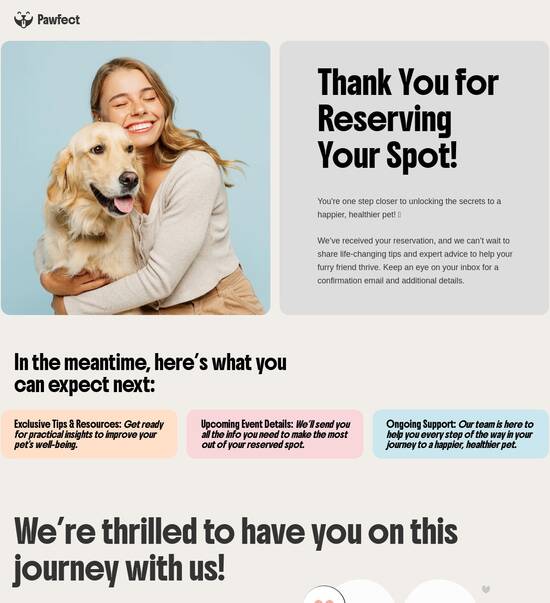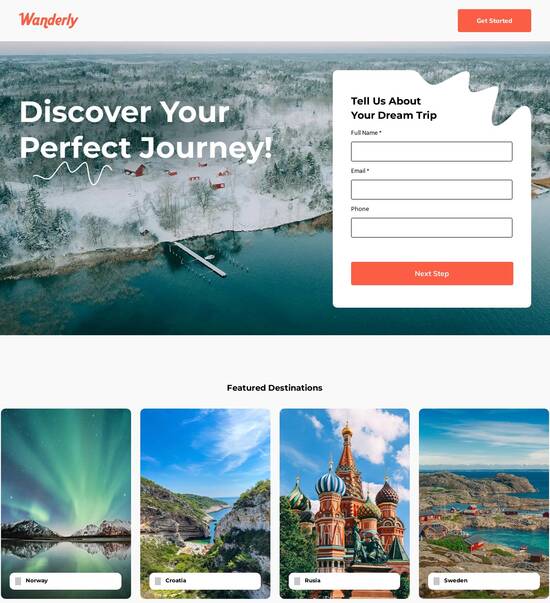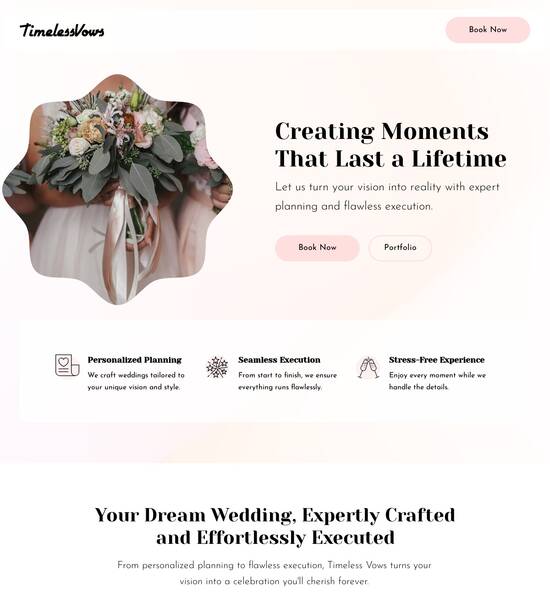
React.js optimized email newsletter page template
Explore Similar TemplatesAbout template
Supercharge your email newsletter page with React.js for outstanding performance! Learn more today.
Recommended templates

Easy to build without coding
With the intuitive drag-and-drop builder, anyone on your team can create high-converting pages without any knowledge of code or design. Make enhancements to your landing page with custom widgets using Javascript, HTML/CSS, or third-party scripts.

Multiple layouts for any industry and goal
Select from 500+ landing page layouts built to boost conversions across industry-specific scenarios. Customize them by adjusting fonts, adding images, and generating on-brand content with the AI assistant. Quickly scale with Instablocks® and Global Blocks that you can save, reuse, and update globally.

Loads fast and looks polished on any device
Every template is responsive, which means they present professionally on any device and load blazingly fast with our Thor Render Engine. You can also power them up with Google AMP technology to deliver an unparalleled mobile experience and drive higher conversions.

Robust analytics & experimentation
Get real-time updates and reporting across all your devices, showing the number of visitors, conversions, cost-per-visitor, and cost-per-lead. Launch AI-powered experiments, run A/B tests, and use heatmaps to analyze user behavior, then optimize your landing page to maximize conversions.







Easy to build without coding
With the intuitive drag-and-drop builder, anyone on your team can create high-converting pages without any knowledge of code or design. Make enhancements to your landing page with custom widgets using Javascript, HTML/CSS, or third-party scripts.
Multiple layouts for any industry and goal
Select from 500+ landing page layouts built to boost conversions across industry-specific scenarios. Customize them by adjusting fonts, adding images, and generating on-brand content with the AI assistant. Quickly scale with Instablocks® and Global Blocks that you can save, reuse, and update globally.
Loads fast and looks polished on any device
Every template is responsive, which means they present professionally on any device and load blazingly fast with our Thor Render Engine.
Robust analytics & experimentation
Get real-time updates and reporting across all your devices, showing the number of visitors, conversions, cost-per-visitor, and cost-per-lead. Launch AI-powered experiments, run A/B tests, and use heatmaps to analyze user behavior, then optimize your landing page to maximize conversions.
All the features you need to build reactjs newsletter
Explore more featuresLearn how to build email template react
Frequently asked questions about react email template
Leading the way in building high-performing landing pages





React js newsletter: Your ultimate how-to guide
Effective landing page optimization is crucial for maximizing ROI on digital marketing campaigns. Instapage provides a powerful platform tailored to marketers, enabling them to create and refine landing pages easily. With its extensive features ranging from high-converting templates to advanced analytics, Instapage is ideal for departments in business services, marketing, tech, education, and more.
Understanding the basics of landing page optimization
Landing page optimization is the practice of improving individual web pages to boost conversions. This process involves testing different elements, analyzing user behavior, and tailoring content to target audiences. Instapage simplifies this process with its built-in tools designed for marketers of all experience levels.
- Pre-built templates: Instapage offers 100+ high-converting templates to kickstart page creation, allowing marketers to focus on their message without worrying about design.
- A/B testing features: Take advantage of A/B testing to compare different versions of your landing pages, ensuring you always choose the most effective options.
- Analytics dashboard: Utilize a comprehensive analytics dashboard to monitor page performance, track user interactions, and gain valuable insights for future campaigns.
Step 1: Create your landing page
Creating a landing page with Instapage is straightforward and efficient. Start by selecting a template that aligns with your campaign objectives. Customize the layout using Instablocks, and add lead generation elements to maximize outreach.
- Choose a template that fits your campaign goals, such as product launches or event registration.
- Modify text and images to reflect your brand and message, focusing on clarity and persuasiveness.
- Incorporate lead generation forms strategically on the page to capture user information.
Step 2: Optimize for conversions
After setting up your page, it's time to enhance its conversion potential. Use instinctive tools like heatmaps and A/B testing to understand visitor behavior and refine page elements accordingly.
- Leverage heatmaps to identify areas of attraction and potential drop-off points, allowing you to make informed adjustments.
- Conduct A/B tests on key elements like headlines and CTA buttons to determine which variants lead to better conversion rates.
- Explore personalization features to tailor user experiences based on audience segments, increasing engagement.
Step 3: Collaborate and analyze
Collaboration is streamlined through Instapage, making it easy for teams to produce and edit pages quickly. Share designs with stakeholders and incorporate their feedback for a polished final product.
- Invite team members to view and comment on designs, enabling collaborative brainstorming and decision-making.
- Roll out page updates in real-time, ensuring that the final product reflects everyone’s input without unnecessary delays.
- Monitor performance over time using analytics, adjusting your strategy based on what the data reveals.
In conclusion, optimizing landing pages using Instapage streamlines the process of creating high-converting digital experiences. By following these steps, marketers can effectively boost their campaign ROIs.
Ready to transform your campaigns? Sign up for Instapage today and see how our platform can elevate your marketing strategy!
People also ask about react newsletter
ReactJS optimized email newsletter page template
Understanding the essence of a reactjs optimized email newsletter page template
Creating an email newsletter is a powerful marketing strategy, especially for businesses aiming to engage their audience consistently. Leveraging ReactJS for this process optimizes the approach and enhances the overall user experience. A well-structured email newsletter page template designed with ReactJS provides a sophisticated way to present information that resonates with subscribers while maintaining an efficient coding structure.
The core concept of reactjs in email newsletters
Email marketing has evolved significantly from its inception. Initially, it was about sending generic messages to lists of recipients. Now, businesses employ targeted strategies, segment lists, and use personalized content to drive engagement. ReactJS plays an important role in enabling marketers to create interactive and responsive email templates that can dynamically adjust to user interactions and preferences.
Modern web development is heavily influenced by frameworks like ReactJS, which allow developers to build applications that provide a smooth user experience. Its efficient rendering architecture makes it ideal for crafting email newsletters where updates and interactions can occur with minimal loading times. The use of ReactJS not only improves the aesthetic appeal of newsletters but also enhances their functionality, ensuring they remain user-friendly.
The integration of ReactJS in email newsletters also allows marketers to implement innovative features that respond to user actions. This interactivity can lead to increased engagement rates, making newsletters more effective tools for brand communication and conversion.
Key features of a reactjs optimized email newsletter page template
One of the most significant advantages of using ReactJS for email newsletter templates is the ability to create reusable components. This modular approach helps streamline development and makes it easy for teams to maintain and update the code as needed. Rather than starting from scratch, developers can use existing components to craft emails efficiently.
Creating modular components allows the design and functionality to be separated, enhancing maintainability.
Reusable components improve team collaboration as members can work on different parts of the application simultaneously without conflicts.
Dynamic content management is another essential feature when designing a ReactJS optimized email newsletter. By leveraging state management and APIs, developers can ensure that your newsletter content remains fresh and relevant, automatically updating to reflect new information or user interactions.
Using state management allows for real-time updates to the newsletter content.
APIs can pull information from external sources, providing subscribers with the latest news, updates, and promotions instantly.
Memoization is crucial for performance optimization in ReactJS applications. By utilizing `React.memo`, developers can prevent unnecessary re-renders of components that have not changed, resulting in faster load times and improved responsiveness across devices.
Using memoization practices can significantly speed up email loading times.
Enhanced responsiveness leads to better user experience, particularly on mobile devices.
Innovative technologies powering reactjs email templates
The JSX syntax used in ReactJS offers an intuitive way to structure your email templates. This feature translates HTML-like syntax into JavaScript, making it easy for developers to create visually appealing and logically structured templates without the steep learning curve typically associated with other languages.
Another innovative technology in ReactJS email templates is styled components. These allow developers to write actual CSS within their JavaScript files, leading to better modularity and easier styling management. This approach creates cleaner code and promotes improved readability.
Moreover, the use of hooks for state and effect management significantly simplifies the way developers handle functions and lifecycle events in components. Hooks such as `useState` and `useEffect` streamline state management, making it easier to create interactive and responsive email newsletters.
Using `useState` allows for flexible management of dynamic content based on user interactions.
`useEffect` can trigger side effects in components, such as making API calls when the component mounts.
Creating custom hooks can lead to reusable logic, promoting cleaner code organization.
Advanced JavaScript features, including ES6+ syntax, enhance code clarity and maintainability. These features allow developers to write concise, efficient code, thereby reducing the amount of boilerplate code needed. Furthermore, asynchronous programming patterns such as promises and async/await enable developers to handle server-side operations seamlessly, improving the overall performance of your newsletter.
Designing user-centric content for email newsletters
To create an effective email newsletter, it's crucial to tailor content to meet user preferences. A/B testing is a popular method to determine what content resonates more with audiences. By experimenting with variations of content layouts, subject lines, and call-to-action buttons, businesses can improve engagement levels.
Conducting A/B tests enables marketers to identify the most effective content strategies.
Gleaning community feedback can provide valuable insights into what your audience enjoys, fostering stronger relationships.
Creating engaging visuals is also vital for capturing attention. React libraries can assist in integrating charts and graphics directly into email newsletters. This approach not only enriches the content but also provides a more dynamic visual experience for subscribers.
Utilizing libraries for data visualization can enhance the presentation of complex information.
Tools for creating stunning graphics can help align branding with content effectively.
Enhancing accessibility and user engagement
Accessibility is an important aspect of email design. Implementing ARIA standards helps ensure that email content is reachable and understandable by assistive technologies. This inclusivity allows for broader engagement, ensuring that newsletters can reach a diverse audience.
Responsive layouts are essential to ensure that email newsletters render well across all devices. Not only does this improve user experience, but it also increases the likelihood of engagement, as readers can easily navigate their emails regardless of screen size.
Boosting engagement can involve implementing interactive elements such as buttons and modals that invite user interaction. Personalization techniques can further enhance user engagement by making content relevant to each subscriber, ultimately driving conversion rates higher.
Interactive elements not only draw attention but also encourage users to take action.
Personalized content through segmentation fosters a sense of connection with the reader.
Managing the reactjs newsletter lifecycle and team collaboration
Efficient component workflows among teams are essential for achieving effective collaboration. Utilizing tools like Git for version control helps keep track of changes and allows multiple team members to work on different components simultaneously.
Setting up a collaborative development environment enhances communication among team members. Regular discussions and update meetings can facilitate smoother workflows and innovate solutions to any challenges faced in the development process.
Version control tools like Git can prevent conflicts and streamline collaboration.
Regular team meetings can foster idea sharing and enhance the quality of the final product.
During development, it's important to ask critical questions to ensure scalability and adaptability. Considerations should involve how the design can accommodate future technologies and user behavior shifts, preparing the template for long-term success.
Assess scalability to prevent future redesigns as your business grows.
Planning for advancing technologies ensures your email remains visually and functionally modern.
Measuring success: analytics and feedback mechanism
Tracking user engagement metrics is integral to understanding the effectiveness of your email newsletters. Integrating tools like Google Analytics provides valuable insight into reader behavior, helping marketers gauge performance and identify areas for improvement.
Collecting user feedback serves as a continuous improvement mechanism. Implementing surveys can help gauge user satisfaction, while analysis of this feedback can unveil patterns that inform content strategy.
Analytics tools help assess overall performance and outline necessary adjustments.
Surveys provide direct user feedback, enhancing your understanding of their needs.
Future trends in reactjs and email newsletter design
Anticipating changes in user behavior and preferences plays a crucial role in shaping future email newsletter strategies. Staying ahead of these trends helps businesses remain relevant and effectively communicate with their audiences.
The role of artificial intelligence in personalized content delivery is expected to increase substantially. Utilizing machine learning algorithms can aid in content curation tailored specifically to individual reader behaviors, driving deeper engagement.
Emerging technologies, including WebAssembly, hold promise in revolutionizing email marketing. Exploring these technologies can empower developers to create more sophisticated and interactive emails, pushing the boundaries of traditional newsletter formats.
Anticipating user trends ensures that your email strategy is proactive rather than reactive.
AI can help in personalizing content further, automating the delivery process.
Staying informed on emerging technologies ensures relevance and competitive advantage in the industry.
Ready to skyrocket conversions?
Supercharge your ad campaigns with high-performing landing pages
Get started














